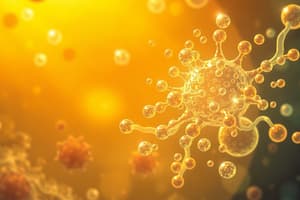Podcast
Questions and Answers
Which method allows for both enumeration and biochemical testing of microorganisms?
Which method allows for both enumeration and biochemical testing of microorganisms?
- Indirect methods
- Culturing (correct)
- Immunological methods
- Molecular biology
Selective media allow all types of bacteria to grow, while differential media only allow certain bacteria to grow.
Selective media allow all types of bacteria to grow, while differential media only allow certain bacteria to grow.
False (B)
What is the purpose of using different types of media, growth temperatures, and atmospheres when culturing microorganisms?
What is the purpose of using different types of media, growth temperatures, and atmospheres when culturing microorganisms?
To support the growth of different microorganisms
A ______ medium has an exact chemical composition that is known.
A ______ medium has an exact chemical composition that is known.
Match the media type with its characteristic:
Match the media type with its characteristic:
Why is MacConkey agar considered a differential medium?
Why is MacConkey agar considered a differential medium?
In enumeration of microorganisms, it is assumed that each colony on a plate originates from multiple bacterial or yeast cells in the original liquid.
In enumeration of microorganisms, it is assumed that each colony on a plate originates from multiple bacterial or yeast cells in the original liquid.
What is the typical unit used to report results in the enumeration of microorganisms?
What is the typical unit used to report results in the enumeration of microorganisms?
In colony counting, a range of ______ colonies is considered countable.
In colony counting, a range of ______ colonies is considered countable.
What is a key advantage of using molecular biology methods, such as PCR, for detecting microorganisms in food compared to culturing methods?
What is a key advantage of using molecular biology methods, such as PCR, for detecting microorganisms in food compared to culturing methods?
PCR can detect only live microorganisms, not dead ones.
PCR can detect only live microorganisms, not dead ones.
Name one advantage of using molecular biology methods over traditional culturing methods for detecting microorganisms.
Name one advantage of using molecular biology methods over traditional culturing methods for detecting microorganisms.
In immunological methods, an ______ is a molecular marker on the microorganism that is unique to that microorganism.
In immunological methods, an ______ is a molecular marker on the microorganism that is unique to that microorganism.
What does an antibody recognize in immunological methods?
What does an antibody recognize in immunological methods?
Lateral flow assays can only be used for quantitative testing in detecting microorganisms.
Lateral flow assays can only be used for quantitative testing in detecting microorganisms.
Name a method that can be used for both qualitative and quantitative testing using immunological methods.
Name a method that can be used for both qualitative and quantitative testing using immunological methods.
Titratable acidity in milk is an example of a(n) ______ method for detecting microorganisms.
Titratable acidity in milk is an example of a(n) ______ method for detecting microorganisms.
What is the primary advantage of indirect methods for detecting microorganisms?
What is the primary advantage of indirect methods for detecting microorganisms?
Complex media have a precisely known chemical composition, allowing for detailed metabolic studies.
Complex media have a precisely known chemical composition, allowing for detailed metabolic studies.
Name one ingredient commonly found in complex media.
Name one ingredient commonly found in complex media.
A medium that allows only gram-negative bacteria to grow, such as MacConkey agar, is an example of a(n) ______ medium.
A medium that allows only gram-negative bacteria to grow, such as MacConkey agar, is an example of a(n) ______ medium.
Which of the following best describes the purpose of differential media?
Which of the following best describes the purpose of differential media?
The primary purpose of enumerating microorganisms is to identify the specific species present in a sample.
The primary purpose of enumerating microorganisms is to identify the specific species present in a sample.
What volume of media is typically plated when enumerating microorganisms?
What volume of media is typically plated when enumerating microorganisms?
The countable range for colonies on a plate is typically between ______ and ______ colonies.
The countable range for colonies on a plate is typically between ______ and ______ colonies.
Which of the following is a disadvantage of culturing microorganisms?
Which of the following is a disadvantage of culturing microorganisms?
The exact chemical composition being unknown is the key characteristic of defined media.
The exact chemical composition being unknown is the key characteristic of defined media.
Besides culturing, list another method used for detecting microorganisms in food.
Besides culturing, list another method used for detecting microorganisms in food.
The use of a suitable ______ in a petri dish is essential for culturing microorganisms.
The use of a suitable ______ in a petri dish is essential for culturing microorganisms.
What is the purpose of using different growth temperatures when culturing microorganisms?
What is the purpose of using different growth temperatures when culturing microorganisms?
Enumeration of microorganisms involves counting the viable and non-viable cells in a sample.
Enumeration of microorganisms involves counting the viable and non-viable cells in a sample.
What does CFU stand for?
What does CFU stand for?
In molecular methods, ______ is a technique used to detect DNA or RNA of specific organisms.
In molecular methods, ______ is a technique used to detect DNA or RNA of specific organisms.
Which type of method provides a more time-efficient way to measure microbial activity?
Which type of method provides a more time-efficient way to measure microbial activity?
The molecular marker that an antibody recognizes is called an antigen.
The molecular marker that an antibody recognizes is called an antigen.
Give an example of an immunological method used in detecting microorganisms.
Give an example of an immunological method used in detecting microorganisms.
While selective media facilitates the growth of chosen microorganisms, ______ media enable differentiation among them based on particular characteristics.
While selective media facilitates the growth of chosen microorganisms, ______ media enable differentiation among them based on particular characteristics.
Which technique allows for the rapid detection of specific DNA or RNA sequences, making it ideal for quick identification of microorganisms?
Which technique allows for the rapid detection of specific DNA or RNA sequences, making it ideal for quick identification of microorganisms?
Defined media cannot be employed for conducting metabolic experiments due to their known compositions.
Defined media cannot be employed for conducting metabolic experiments due to their known compositions.
A food sample is diluted to $10^{-5}$, and after plating, the count is determined to be 65. What is the bacterial load of the sample?
A food sample is diluted to $10^{-5}$, and after plating, the count is determined to be 65. What is the bacterial load of the sample?
In a given media, if the number of colonies exceeds 300 per plate, the count is considered ______.
In a given media, if the number of colonies exceeds 300 per plate, the count is considered ______.
Flashcards
Microorganism Detection
Microorganism Detection
Methods to find, name, and count microbes in food.
Culturing Microorganisms
Culturing Microorganisms
Growing microorganisms in a controlled environment.
Defined Media
Defined Media
Media where the exact chemical composition is known.
Complex Media
Complex Media
Signup and view all the flashcards
Selective Media
Selective Media
Signup and view all the flashcards
Differential Media
Differential Media
Signup and view all the flashcards
Enumeration of Microorganisms
Enumeration of Microorganisms
Signup and view all the flashcards
PCR
PCR
Signup and view all the flashcards
Antigen
Antigen
Signup and view all the flashcards
Antibody
Antibody
Signup and view all the flashcards
Indirect Methods
Indirect Methods
Signup and view all the flashcards
CFU
CFU
Signup and view all the flashcards
Study Notes
- Methods for detecting, identifying, and counting microorganisms in food include culturing, molecular biology, immunological methods, and other techniques.
Culturing Microorganisms
- Growing organisms on suitable media in a petri dish allows for their study.
- Different organisms require different growth conditions.
- Media types, temperatures, and atmospheres influence microorganism growth.
- Culturing can be selective or differential, enabling enumeration and biochemical testing.
Defined vs. Complex Media
- Defined media have a known chemical composition, are used for metabolic experiments, and are more difficult to prepare.
- Complex media have an unknown chemical composition, contain ingredients like casein digest, soybean digest, and yeast extracts, and are easier to make.
Selective and Differential Media
- Media can be both selective and differential.
- Selective media allow only certain bacteria to grow.
- Differential media allow many bacteria to grow but distinguish their characteristics.
- MacConkey agar selects for gram-negative bacteria and differentiates lactose fermenters, which appear pink.
Enumeration of Microorganisms
- Organisms are grown in a suitable medium at different dilutions, and colonies are counted after a growth period (1-3 days), typically with 1 mL of media plated.
- Each colony on a plate is assumed to originate from a single bacterial or yeast cell in the original liquid.
- The countable range is 30-300 colonies; plates with <30 colonies can have estimated counts, while >300 colonies are too numerous to count.
- Results are reported in CFU (colony-forming units)/mL in the original sample.
Molecular Biological Methods
- Polymerase chain reaction (PCR) can detect DNA or RNA of specific organisms, aiding identification or quantification, and it is faster than culturing.
Immunological Methods
- Antigens are unique molecular markers on microorganisms.
- Antibodies recognize these molecular markers.
- Lateral flow assays are available for qualitative testing, and ELISA can be used for quantitative testing.
Other Detection Methods
- Indirect methods offer a more time-efficient measure of microbial activity.
- An example is titratable acidity in milk.
Studying That Suits You
Use AI to generate personalized quizzes and flashcards to suit your learning preferences.




